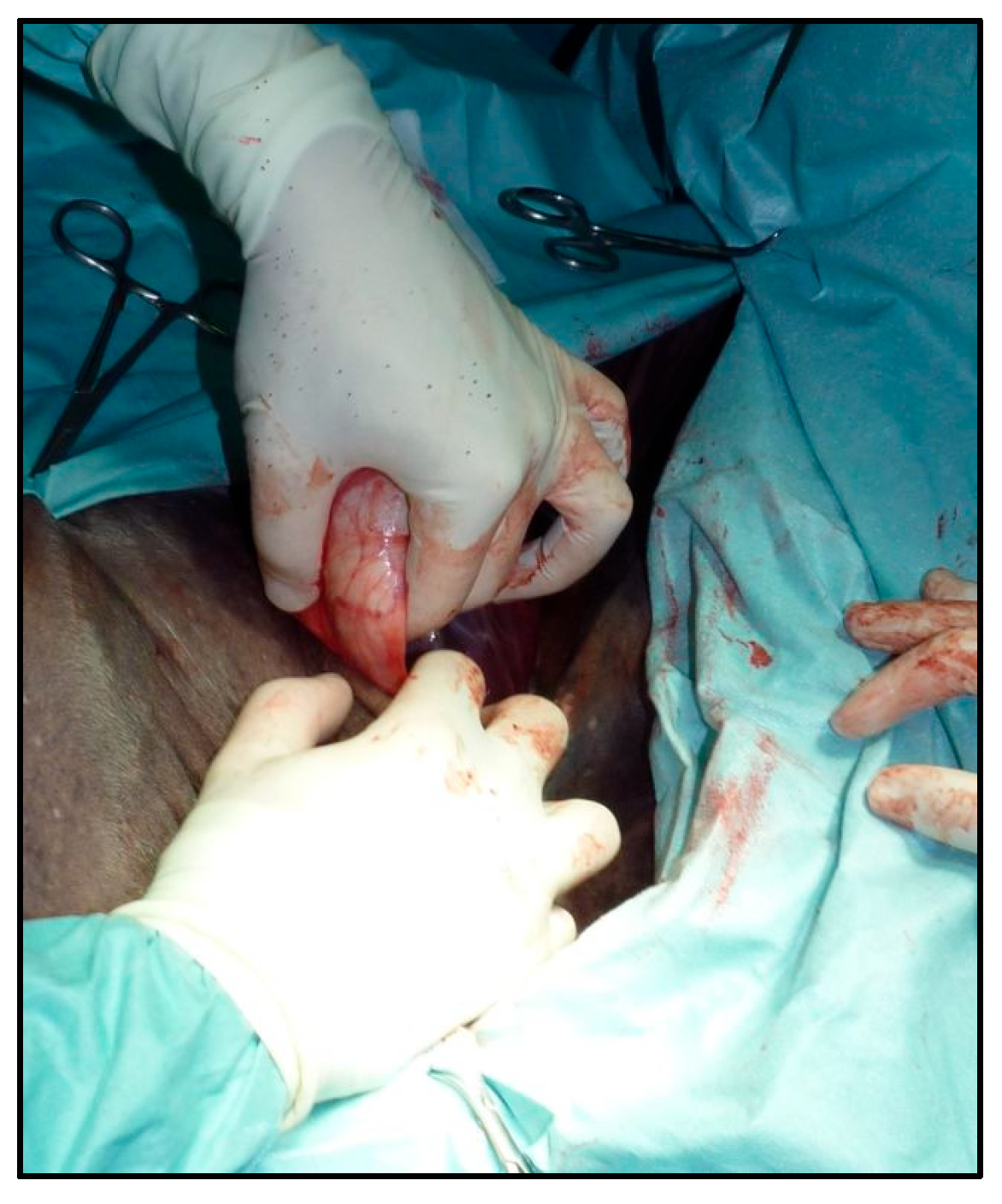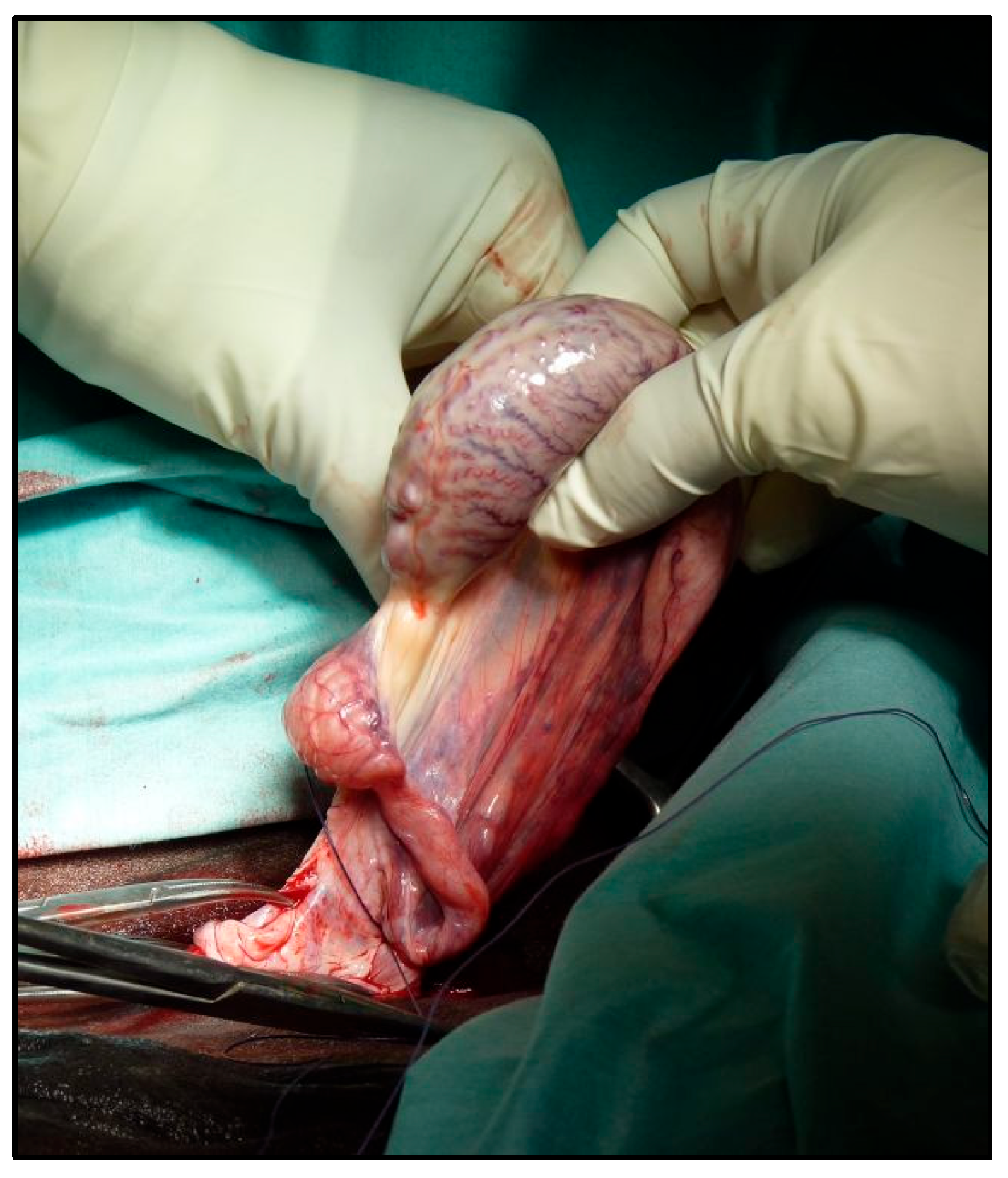Description and Complications of a New Modified Semi-Closed Castration Technique in Horses
Simple Summary
Abstract
1. Introduction
2. Materials and Methods
2.1. Animals
2.2. Preoperative Preparation
2.3. Anesthesia
2.4. Surgical Technique
2.5. Postoperative Care and Outcome
3. Results
4. Discussion
- Closed: The vaginal process remains intact throughout the procedure and is not opened;
- Open: The vaginal process is opened and remains open at the conclusion of the procedure;
- Semi-closed: The vaginal process is initially opened for inspection or manipulation and then securely closed at the end of the surgery.
5. Conclusions
Author Contributions
Funding
Institutional Review Board Statement
Informed Consent Statement
Data Availability Statement
Conflicts of Interest
References
- Kilcoyne, I.; Spier, S.J. Castration Complications: A Review of Castration Techniques and How to Manage Complications. Vet. Clin. N. Am. Equine Pract. 2021, 37, 259–273. [Google Scholar] [CrossRef] [PubMed]
- Schumacher, J. Testis. In Equine Surgery, 3rd ed.; Auer, J., Ed.; WB Saunders: St Louis, MO, USA, 2006; pp. 775–809. [Google Scholar]
- Dubuc, J.; Morrow, L. Open versus semi-closed castration in horses: Which technique results in fewer postoperative complications? Vet. Rec. 2023, 192, 78. [Google Scholar] [CrossRef] [PubMed]
- de Moura Alonso, J.; de Melo-Neto, G.B.; Dos Santos, B.; Mogollon Garcia, H.D.; Pinheiro Paim, K.; Pinheiro Ferreira, J.C.; Santos Schmidt, E.M.; Ferreira da Silva, A.N.; Marques da Cunha, G.; Takahira, R.K.; et al. Inflammatory response of miniature horses subjected to open and half-closed orchiectomy techniques. Vet. Rec. 2021, 189, e240. [Google Scholar] [CrossRef] [PubMed]
- Crosa, A.T.; Desjardins, M.R. Minimally invasive, compartmentalized, modified open castration technique with primary closure in equids. J. Am. Vet. Med. Assoc. 2018, 253, 897–906. [Google Scholar] [CrossRef] [PubMed]
- Riemersma, D.J.; Fahlbusch, G.; Rijkenhuizen, A.B.M. Closed inguinal castration technique in horses compared with field castrations using post-operative serum amyloid A analysis. Equine Vet. Educ. 2024, 3, 586–596. [Google Scholar] [CrossRef]
- Rodden, E.B.K.; Suthers, J.M.; Busschers, E.; Burford, J.H.; Freeman, S.L. A scoping review on intraoperative and postoperative surgical castration complications in domesticated equids. Equine Vet. J. 2024, 56, 1115–1128. [Google Scholar] [CrossRef] [PubMed]
- Carmalt, J.L.; Shoemaker, R.W.; Wilson, D.G. Evaluation of common vaginal tunic ligation during field castration in draught colts. Equine Vet. J. 2008, 40, 597–598. [Google Scholar] [CrossRef] [PubMed]
- Kummer, M.; Gygax, D.; Jackson, M.; Bettschart-Wolfensberger, R.; Fürst, A. Results and complications of a novel technique for primary castration with an inguinal approach in horses. Equine Vet. J. 2009, 41, 547–551. [Google Scholar] [CrossRef] [PubMed]
- Petrizzi, L.; Fürst, A.; Lischer, C. Clinical evaluation of a vessel sealing device (LigaSureTM) for haemostasis of the testicular vessels for castration of stallions using an inguinal approach and primary closure. Wien. Tierarztl. Monatsschrift 2006, 93, 120–126. [Google Scholar]
- Comino, F.; Giusto, G.; Caramello, V.; Pagliara, E.; Bellino, C.; Gandini, M. Ex vivo comparison of the giant and transfixing knot in equine open and closed castration. Equine Vet. J. 2016, 48, 765–769. [Google Scholar] [CrossRef] [PubMed]
- Gandini, M.; Giusto, G. Development of a classification system for equine postoperative complications and its application in a cohort of 190 horses undergoing emergency laparotomy. Vet. Rec. 2023, 192, e2782. [Google Scholar] [CrossRef] [PubMed]
- Mason, B.J.; Newton, J.R.; Payne, R.J.; Pilsworth, R.C. Costs and complications of equine castration: A UK practice-based study comparing ‘standing nonsutured’ and ‘recumbent sutured’ techniques. Equine Vet. J. 2005, 37, 468–472. [Google Scholar] [CrossRef] [PubMed]





Disclaimer/Publisher’s Note: The statements, opinions and data contained in all publications are solely those of the individual author(s) and contributor(s) and not of MDPI and/or the editor(s). MDPI and/or the editor(s) disclaim responsibility for any injury to people or property resulting from any ideas, methods, instructions or products referred to in the content. |
© 2025 by the authors. Licensee MDPI, Basel, Switzerland. This article is an open access article distributed under the terms and conditions of the Creative Commons Attribution (CC BY) license (https://creativecommons.org/licenses/by/4.0/).
Share and Cite
Gandini, M.; Bertone, C.; Giusto, G. Description and Complications of a New Modified Semi-Closed Castration Technique in Horses. Vet. Sci. 2025, 12, 720. https://doi.org/10.3390/vetsci12080720
Gandini M, Bertone C, Giusto G. Description and Complications of a New Modified Semi-Closed Castration Technique in Horses. Veterinary Sciences. 2025; 12(8):720. https://doi.org/10.3390/vetsci12080720
Chicago/Turabian StyleGandini, Marco, Cristina Bertone, and Gessica Giusto. 2025. "Description and Complications of a New Modified Semi-Closed Castration Technique in Horses" Veterinary Sciences 12, no. 8: 720. https://doi.org/10.3390/vetsci12080720
APA StyleGandini, M., Bertone, C., & Giusto, G. (2025). Description and Complications of a New Modified Semi-Closed Castration Technique in Horses. Veterinary Sciences, 12(8), 720. https://doi.org/10.3390/vetsci12080720




